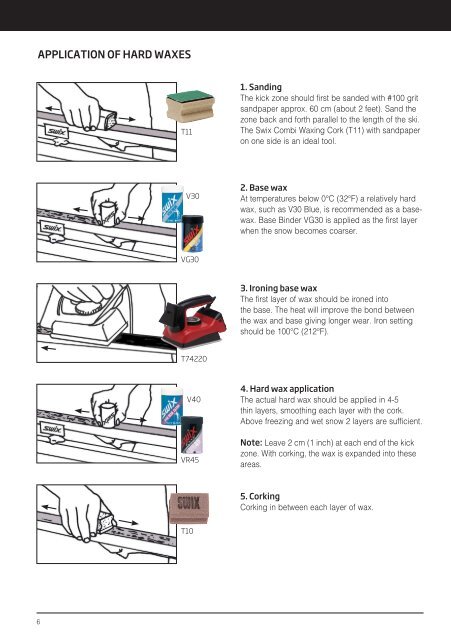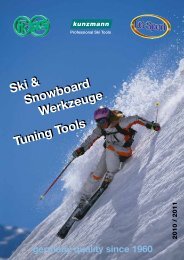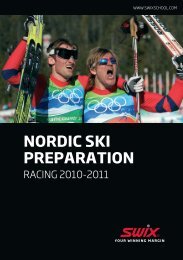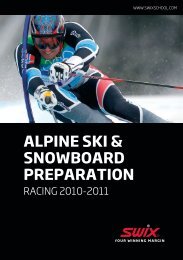WAXING GUIDE
WAXING GUIDE
WAXING GUIDE
You also want an ePaper? Increase the reach of your titles
YUMPU automatically turns print PDFs into web optimized ePapers that Google loves.
APPLICATION OF HARD WAXESSWIX HARD WAXEST11V30VG30T74220V40VR451. SandingThe kick zone should first be sanded with #100 gritsandpaper approx. 60 cm (about 2 feet). Sand thezone back and forth parallel to the length of the ski.The Swix Combi Waxing Cork (T11) with sandpaperon one side is an ideal tool.2. Base waxAt temperatures below 0°C (32°F) a relatively hardwax, such as V30 Blue, is recommended as a basewax.Base Binder VG30 is applied as the first layerwhen the snow becomes coarser.3. Ironing base waxThe first layer of wax should be ironed intothe base. The heat will improve the bond betweenthe wax and base giving longer wear. Iron settingshould be 100°C (212°F).4. Hard wax applicationThe actual hard wax should be applied in 4-5thin layers, smoothing each layer with the cork.Above freezing and wet snow 2 layers are sufficient.Note: Leave 2 cm (1 inch) at each end of the kickzone. With corking, the wax is expanded into theseareas.The V-line is made both for racing and ski touring.The high quality is due to high-grade raw materialsand proven formulas that are continually adjustedto improve effectiveness.Along with the two temperature ranges shown onthe label are two snow-type symbols. One for newand falling snow, and one for older, fine grainedsnow.Note: All temperatures given on Swix waxesare air temperatures measured in the shade.V20 GREENV30 BLUENew fallen snow-8°C to -15°C (18°F to 5°F)Old, transformed snow-10°C to -18°C (12°F to 0°F)New fallen snow-2°C to -10°C (28°F to 14°F)Old, transformed snow-5°C to -15°C (23°F to 5°F)New fallen snow-1°C to -7°C (30°F to 19°F)Old, transformed snow-3°C to -10°C (27°F to 12°F)Waxing for new snow and fine grained snowOn new snow a harder (colder) wax is applied thanon older snow. The reason for this is that new snowcrystals are sharper and have better penetrationinto the wax giving better kick. Older snow particlesare more rounded and a softer wax is needed toget sufficient kick.Therefore Swix has introduced a system showingtwo different temperature intervals on all waxes,one for the new snow and one for the older snow.This makes it easier to find the right wax. Do not beconcerned about applying a wax that is one step“warmer” than what the temperature is indicating ifthe snow has become coarser. Normally the snowtransforms from new to fine grained after a coupleof days, although this process might happen fasterclose to 0°C (32°F).V50 VIOLETNew fallen snow0°C to -1°C (32° to 30°F)Old, transformed snow-1°C to -3°C (30°F to 27°F)New fallen snow+1°C to 0°C (34°F to 32°F)Old, transformed snow0°C to -2°C (32°F to 28°F)5. CorkingCorking in between each layer of wax.V40 BLUE EXTRAV55 RED SPECIALT10New fallen snow0°C to -3°C (32°F to 27°F)New fallen snow+3°C to 0°C (38°F to 32°F)Old, transformed snow-2°C to -6°C (28°F to 21°F)Old, transformed snow+1°C to -1°C (34°F to 30°F)V45 VIOLET SPECIALV60 RED/SILVER6 7





